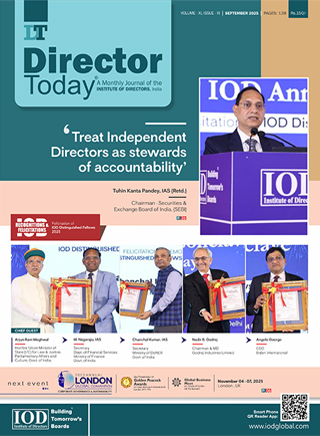RBI Annual Report 2024–25: Stability Delivered, But Direction Deferred

The Reserve Bank of India's Annual Report for 2024–25 reads as a testament to institutional discipline. Inflation has eased to 5.4 percent. Foreign exchange reserves have climbed to $645.6 billion. Fiscal prudence has improved with the general government deficit narrowing to 4.7 percent of GDP. On the surface, India appears to have held its ground admirably in a fragile global environment. But a deeper reading reveals a system now flush with liquidity and short on urgency. The average daily liquidity absorption stood at Rs.1.6 lakh crore through the year, which is over three times the previous year's levels, even as the policy rate remained at 6.5 percent. Until recently, the RBI continued to inject liquidity through repo auctions and open market operations. However, in June 2025, it initiated liquidity-tightening steps such as VRRR (Variable Rate Reverse Repo) auctions , signaling the start of recalibration - though questions remain around timing and consistency. The question this raises is not whether the RBI did too much or too little, but whether it is signalling clearly enough to the real economy and markets.
If liquidity remains abundant without recalibration, monetary transmission may weaken, pricing distortions may creep in, and capital may flow to convenience over productivity. The recent surge in portfolio flows ($40.6 billion) against a halving of net FDI ($10.6 billion) hints at exactly this dissonance - asset markets buoyed by sentiment, not strategy.
There is also a quiet retreat from themes that should be getting louder. Climate risk, which received sharp emphasis in past reports, is quite muted. In a year when India saw rising food price volatility due to climate shocks, the absence of a bold regulatory push toward green financing, ESG screening, and climate-adjusted risk modelling is notable. With the right framework, climate alignment can become a magnet for foreign capital, not a compliance burden.
On the digital frontier, the central bank's e-rupee (CBDC) initiative has grown to Rs.1,016 crore in circulation. Pilots are being explored for cross-border use. Yet, the report offers little clarity on the role CBDC will play within India's broader payments ecosystem. As UPI volumes continue to surge and digital fraud cases remain elevated, a sharper vision for CBDC, whether as a retail innovation, AML tool, or financial inclusion bridge is urgently needed.
Perhaps most concerning are the rising operational risks. The total value of bank frauds tripled to Rs.36,014 crore, with public sector banks accounting for the bulk of losses and private banks reporting the most cases. Detection delays, reclassification of old cases, and digital payment vulnerabilities all point to a trust risk that must be addressed proactively. Meanwhile, counterfeit Rs.200 and Rs.500 notes rose by 13.9 percent and 37.3 percent respectively, demanding better monitoring.
None of this is to diminish what has been achieved. The RBI's balance sheet expanded by 8.2 percent. Income rose by 22.77 percent, driven by strong forex gains. Gold holdings increased by over 57 metric tonnes. But surpluses are not a strategy. They become consequential only when deployed to strengthen transmission, fuel innovation, or de-risk the system.
What is needed now is not a reset, but a reframing from stability as a destination to stability as a launch-pad. A few imperatives emerge clearly:
• Define a credible liquidity normalisation path. The silence around future VRR auctions or OMO recalibration undermines predictability and effectiveness.
• Re-energise FDI frameworks to welcome long-term private equity, credit, and climate-aligned capital, not just volatile flows.
• Reassert RBI's climate mandate across regulation, credit, and supervision - this is a strategic lever, not a thematic add-on.
• Publish a forward-looking CBDC roadmap, aligned with financial system resilience and public adoption goals.
• Tighten fraud and counterfeiting controls using AIenabled detection and stronger institutional accountability.
The RBI has shown it can manage risk. Now it must lead in shaping direction. With global headwinds intensifying and domestic expectations rising, India's financial stability must graduate from a policy shield to a strategic asset.
Author

Ms. Chandni Khosla
She is a seasoned Independent Director, Board Advisor, and ESG Strategist with over two decades of expertise in financial services, corporate governance, and sustainable finance across Asia, the Middle East, and emerging markets. Currently, she serves as Director at Neo Securities Limited and holds advisory roles at Synergos (UAE) and Super Start Nurseries LLC (UK). With a strong track record in strategic positioning and ESG leadership, she has previously worked with Singapore Exchange, NSE India, HDFC Limited, ICICI Bank, Natixis, and SHUAA Capital PSC.
Owned by: Institute of Directors, India
Disclaimer: The opinions expressed in the articles/ stories are the personal opinions of the author. IOD/ Editor is not responsible for the accuracy, completeness, suitability, or validity of any information in those articles. The information, facts or opinions expressed in the articles/ speeches do not reflect the views of IOD/ Editor and IOD/ Editor does not assume any responsibility or liability for the same.

 Quick Links
Quick Links
 Connect us
Connect us




 Back to Home
Back to Home































